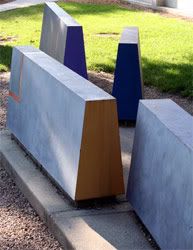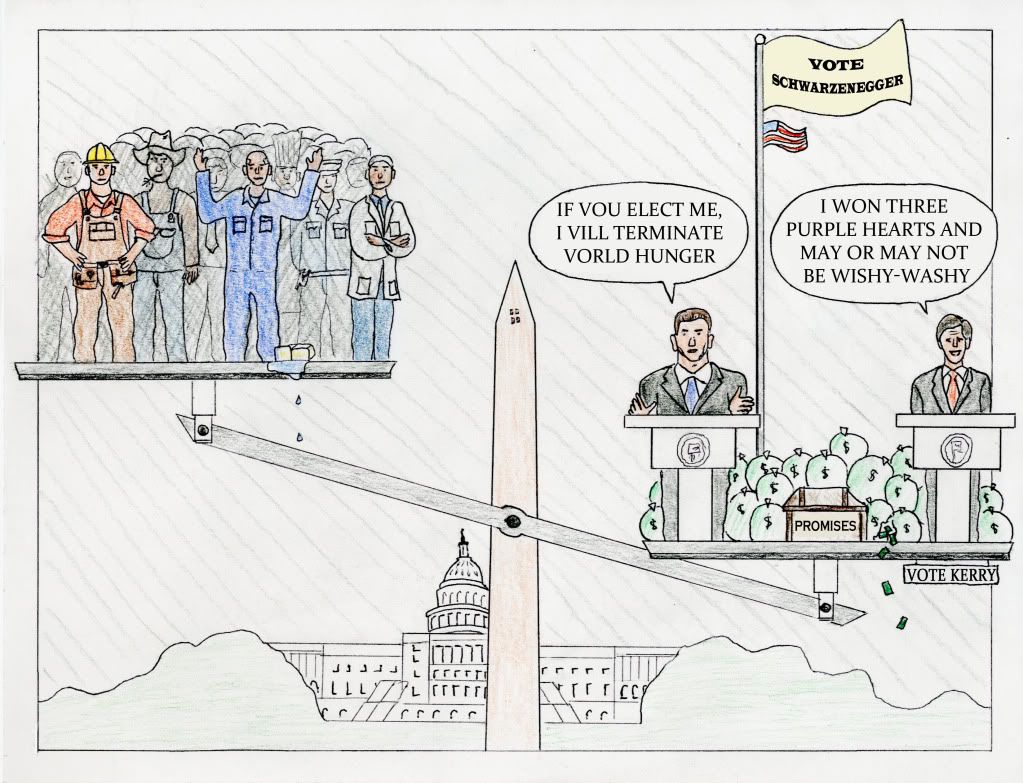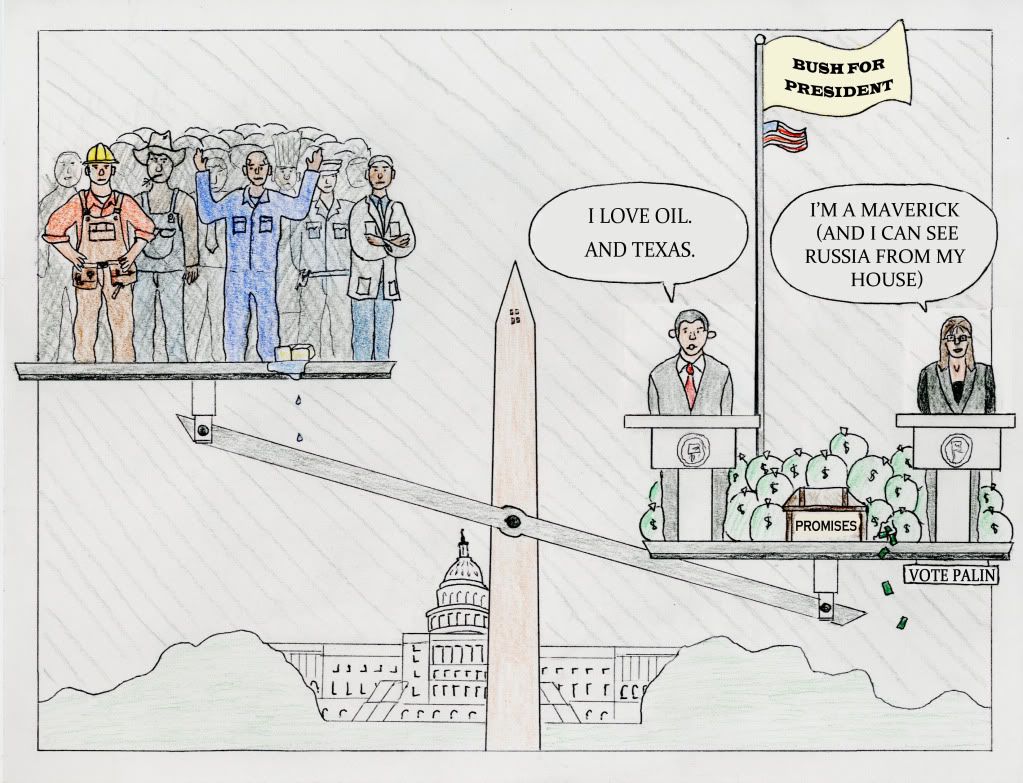 In looking at the sculpture Variable Wedge by Sam Richardson, there are many rhetorical techniques, strategies, and concepts utilized to make certain appeals to its audience. When one first observes the sculpture, the first thing that the eye notices is the form of the "wedge," and how the title plays into this form. The sculpture consists of seven separate sections of a wedge, or triangular-shaped form as viewed from the side, which has the cross section of a regular trapezoid. When viewed from the side (North or South views), it appears as a complete wedge. When looked at from any other view, however, one notices that the fifth and sixth sections within this wedge sort of branch out from the linear pattern established within the first four sections. The fifth is rotated so that it is branches out toward the North, while the sixth one branches out toward the South. Finally, then, the seventh section is oriented in-line with the first four sections, as it is back on track. This form, whose title makes sense with the orientation of the piece, begins to possibly establish a narrative for the entire sculpture, one of progression from small to large through time: possibly even growth. The trapezoidal cross-section, however, as well as the geometric shape appeal to logos, as it is a stable form, with a large base.
In looking at the sculpture Variable Wedge by Sam Richardson, there are many rhetorical techniques, strategies, and concepts utilized to make certain appeals to its audience. When one first observes the sculpture, the first thing that the eye notices is the form of the "wedge," and how the title plays into this form. The sculpture consists of seven separate sections of a wedge, or triangular-shaped form as viewed from the side, which has the cross section of a regular trapezoid. When viewed from the side (North or South views), it appears as a complete wedge. When looked at from any other view, however, one notices that the fifth and sixth sections within this wedge sort of branch out from the linear pattern established within the first four sections. The fifth is rotated so that it is branches out toward the North, while the sixth one branches out toward the South. Finally, then, the seventh section is oriented in-line with the first four sections, as it is back on track. This form, whose title makes sense with the orientation of the piece, begins to possibly establish a narrative for the entire sculpture, one of progression from small to large through time: possibly even growth. The trapezoidal cross-section, however, as well as the geometric shape appeal to logos, as it is a stable form, with a large base.Thursday, April 8, 2010
WP3: Second Post
 In looking at the sculpture Variable Wedge by Sam Richardson, there are many rhetorical techniques, strategies, and concepts utilized to make certain appeals to its audience. When one first observes the sculpture, the first thing that the eye notices is the form of the "wedge," and how the title plays into this form. The sculpture consists of seven separate sections of a wedge, or triangular-shaped form as viewed from the side, which has the cross section of a regular trapezoid. When viewed from the side (North or South views), it appears as a complete wedge. When looked at from any other view, however, one notices that the fifth and sixth sections within this wedge sort of branch out from the linear pattern established within the first four sections. The fifth is rotated so that it is branches out toward the North, while the sixth one branches out toward the South. Finally, then, the seventh section is oriented in-line with the first four sections, as it is back on track. This form, whose title makes sense with the orientation of the piece, begins to possibly establish a narrative for the entire sculpture, one of progression from small to large through time: possibly even growth. The trapezoidal cross-section, however, as well as the geometric shape appeal to logos, as it is a stable form, with a large base.
In looking at the sculpture Variable Wedge by Sam Richardson, there are many rhetorical techniques, strategies, and concepts utilized to make certain appeals to its audience. When one first observes the sculpture, the first thing that the eye notices is the form of the "wedge," and how the title plays into this form. The sculpture consists of seven separate sections of a wedge, or triangular-shaped form as viewed from the side, which has the cross section of a regular trapezoid. When viewed from the side (North or South views), it appears as a complete wedge. When looked at from any other view, however, one notices that the fifth and sixth sections within this wedge sort of branch out from the linear pattern established within the first four sections. The fifth is rotated so that it is branches out toward the North, while the sixth one branches out toward the South. Finally, then, the seventh section is oriented in-line with the first four sections, as it is back on track. This form, whose title makes sense with the orientation of the piece, begins to possibly establish a narrative for the entire sculpture, one of progression from small to large through time: possibly even growth. The trapezoidal cross-section, however, as well as the geometric shape appeal to logos, as it is a stable form, with a large base.Wednesday, April 7, 2010
WP3: First Post
 In the past, I have had some experiences with art objects, and am familiar with a few of the processes used to make art. Ever since I was a youngster, I have had an unconscious fascination with art, and have always enjoyed creating things. Thus, all the way up through middle school, I thoroughly enjoyed the art classes I took. Furthermore, although my schedule in high school didn't allow me to take such courses, I continued to occasionally paint and draw on my on time. Currently, as an architecture student, I am required to take the visual literacy courses, such as drawing and painting classes, in which I have learned how to better create such art. In addition, classes such as Analysis and Composition have allowed me to better understand the form of certain pieces of art using tension, balance, hierarchy, etc.
In the past, I have had some experiences with art objects, and am familiar with a few of the processes used to make art. Ever since I was a youngster, I have had an unconscious fascination with art, and have always enjoyed creating things. Thus, all the way up through middle school, I thoroughly enjoyed the art classes I took. Furthermore, although my schedule in high school didn't allow me to take such courses, I continued to occasionally paint and draw on my on time. Currently, as an architecture student, I am required to take the visual literacy courses, such as drawing and painting classes, in which I have learned how to better create such art. In addition, classes such as Analysis and Composition have allowed me to better understand the form of certain pieces of art using tension, balance, hierarchy, etc. Tuesday, April 6, 2010
WP2: Final Comic
Author's Note
The central theme surrounding my comic, as mentioned in the statement of purpose, is that politicians live in a different world than the average American. As demonstrated through their financial status, fame and fortune, as well as political agendas, the lifestyle of a politician often juxtaposes that of the public, and prompts the questioning of their true representation of the people. Communicating this message to my audience via a comic was no easy task, and it involved an ongoing editing process, working with aesthetic and structural elements.
Lastly, in order to make the comic unique, I tried to break away from some of the norms associated with that medium. One such decision, which engages the audience, is to sever the frame of the various panels with the subject matter. By intersecting the frames with the mop bucket and scale, the audience’s attention is called to this subject matter, making them think about what the objects represent and how they fit into the comic. In addition, because the comic is published on a blog, I thought about how I could utilize that context to further break some of the other norms. Thus, creating an “alternate ending,” was a structural choice that allowed me to add another dimension to the comic.
Statement of Purpose


